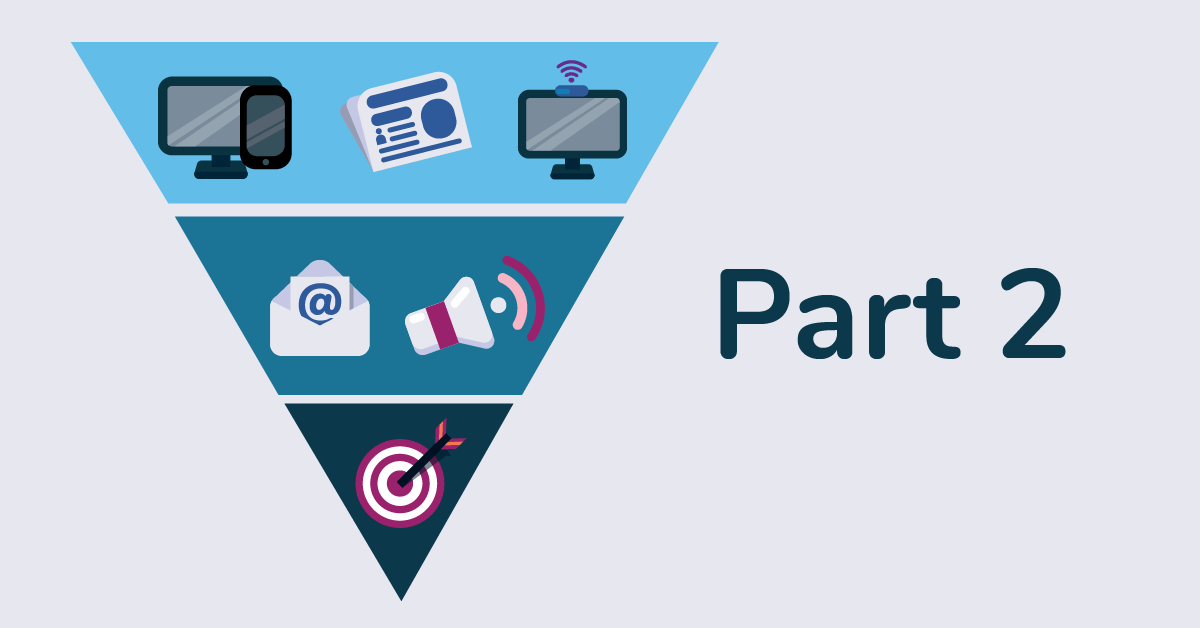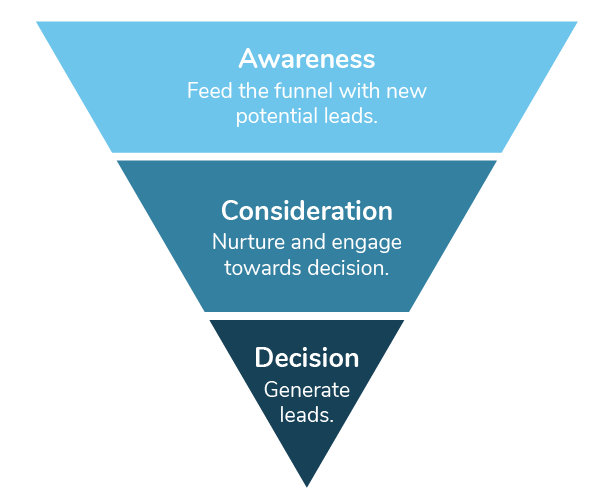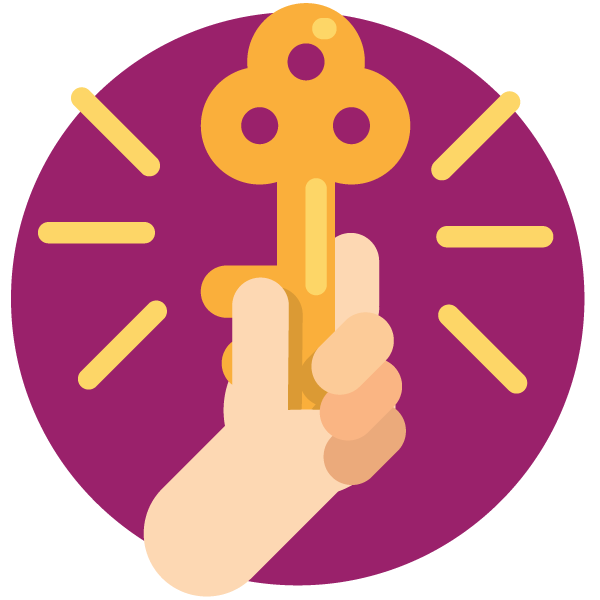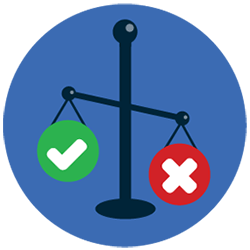MPP’s Full-Funnel Marketing Crash Course: Part 2

In part one of our crash course guide to full-funnel marketing, you learned the importance of using a full-funnel marketing strategy for your business and how to create a unique marketing funnel. Today, we’re going to explore the three stages of the marketing funnel and different advertising strategies you can use to stay in front of your target audience during their buyer journey.
Full-funnel marketing strategy recap
Remember the marketing funnel? If not, here’s a quick refresher:
The marketing funnel has three stages – awareness, consideration, and decision. The top of the marketing funnel is the widest and captures as many potential customers as possible. As prospects move down the funnel, some will drop out, narrowing your pool. At the final stage, decision, your prospects will decide whether to make a purchase. All three parts of the funnel work together to convert potential consumers into buyers.

With a full-funnel strategy, you advertise to your customers at all stages of their buyer journey. Once you figure out the consumer decision-making process, you use marketing strategies that appeal to your customer — from awareness-boosting tactics like Out-of-Home billboards, to automated email lists, your marketing should start broad at the top of the funnel to attract as many prospects as possible and become more targeted as they move down. Remember, every marketing funnel is different, and there are many variations to the types of content you can use for each of the buyer’s journey stages. This post is meant to spark ideas to help you map out your own full-funnel marketing strategy.
Awareness stage
During the awareness stage, potential buyers are to trying to solve problems, find an answer, or meet a need by researching potential solutions. They don’t know about your business, so it’s up to you to educate them about your products or services.
A mistake many brands make is putting decision-stage ads and web pages in front of people that aren’t yet ready to see them. This is not the time to go for a hard sale. Prospects are taking actions like visiting your website for the first time or checking out your social media profiles. This is an opportunity to tell your story and provide content to educate and entertain them.
When your goal is boosting awareness, you have a variety of marketing tactics at your disposal. Although you’re casting a wide net to get your brand in front of as many people as possible, your marketing still needs to be strategic. Here are some ideas you can implement.
Blog posts
Write blog posts about engaging topics to lead search engine users directly to your website. Your blog should provide value and educate your customers about your business or brand. To generate blog content ideas, ask yourself:
- What kinds of questions do your customers ask? Can you answer those questions in long-format posts?
- Are there any helpful how-to’s or tips and tricks you can share with your audience?
- What keywords do you want to use to have your audience organically find you? What topics can you write about that use these terms?
Social media
Both paid and organic social media marketing can be great for boosting awareness. Research shows that people spend an average of 2.5 hours per day on various social platforms. That’s a lot of time spent scrolling! This is a perfect opportunity for you to get in front of people! Your social feeds can be a resource for infographics, news articles, company updates, blog posts, and more. These organic social posts can help establish your credibility in your industry. Paid social media ads allow you to get in front of specific target audiences, tap into valuable customer insights, and allow you to retarget prospects further down the funnel.
Other paid advertising
Get your message out there with a blend of digital and traditional marketing. OOH (Out-of-Home), audio, display, and native are all great ways to boost brand awareness. This mix of digital and traditional tactics ensures you are in front of your audience when they are online and on the go. Your potential customers may see your content on social media or a display ad on one of their favorite websites. They may see your billboard as they are driving to an appointment or an audio ad as they listen to their favorite podcast.

Consideration stage
If your prospect makes it to the consideration stage, well done! They’ve made it one step further down your marketing funnel. You have captured their attention and they are eager to learn more about your business. At the consideration stage, they are weighing their options and comparing products.
Mid-funnel marketing is for more serious prospects who are comparing solutions, so the content and tactics in your marketing plan should align with their goals. These potential customers know who you are and what you do – now it’s your job to go one step further and convince them that your brand or product is the best solution.
As the funnel starts to narrow, your marketing tactics must be persuasive, educational, and targeted to have the most impact on your audience. How can you achieve this? Here are some consideration-stage marketing tactics:
Downloadable content
Information-rich, downloadable content needs to be more tantalizing than an average blog post. This content is usually gated, meaning a user must share personal information, like an email address, to access it. Some downloadable resources you might consider offering includes:
- Fact sheets
- Checklists
- Ebooks
- White papers
- Case studies
Most importantly, make sure your downloadable content holds value. The mid-funnel audience expects the best information you have to offer.
Webinars
Webinars offer a deeper level of educational information and help connect you with your audience in a more meaningful way. Determine if you have enough interest in a webinar by testing the waters. Add a sign-up CTA at the bottom of your awareness-stage content or poll social users to see if you can fill enough slots to make it worth your while.
If you have enough interest, make the most of your webinar by asking for attendee information during the sign-up process. Consider using a personalized form to see why people are interested in attending, how they found you, etc. This is an opportunity to assess where the attendee is in the marketing funnel, which can be used later to segment these groups in your follow-up marketing.
Automated email
Take advantage of automation tools and nurture your email strategy through segmentation. Age, gender, and geography are all important demographics, but behavior-driven segments are also valuable. For example, a prospect who subscribes through your newsletter will follow a different path than someone who entered your funnel through a display campaign. Both users expect distinct types of emails, so keep segmentation intentional.


Decision stage
Congrats! We’ve made it to the final stage – decision. At the decision stage, customers know they want your product but may need a reminder to purchase or a push to fully commit to buying. By the time prospects reach the decision stage want to know about how you’ve helped others solve their problems or met their needs.
Don’t slack off in this part of the funnel. Although you’re this close to potentially closing a sale, ask yourself: am I making the purchase process as simple as possible? Your buyer has made it to the final stretch, so don’t scare them away by overcomplicating things. Some marketing tactics you can use to help win buyers at the decision phase include:
Testimonials
The best type of content at the decision stage doesn’t come from you —it comes from people who have already purchased your product. Testimonials and case studies can convince those at the bottom of your funnel to take the last step to become a customer. Highlight testimonials, reviews, or case studies when you can.
Free trials
Give buyers a taste of your product by offering a free trial. An introductory trial gives potential consumers a taste of what you do but remember not to give the whole thing away. Leave buyers wanting more, since your objective is to convert them to a sale.
Retargeting
92% of customers don’t purchase on their first visit to a website — which is why it’s crucial to follow them and make sure they enter back into the marketing funnel at the right stage. With retargeting, you’re reaching a specific audience and delivering a tailored value proposition to that group. If a website visitor reads one of your blog posts about the best types of energy efficient windows for your home, you can use retargeting to show them ads for a free ebook about the benefits of energy efficient windows, or perhaps offer a free consultation from one of your window specialists.
Continue to improve your marketing funnel
If you don’t have a marketing funnel yet, it’s time to start building one. Shifting your marketing strategy to a full funnel can seem overwhelming at first, but the results will help your brand awareness, sales, ROI, and optimization. Start by establishing your buyer journey and fill the funnel with tailored content that appeals to them at every stage. There is not a magical solution that will work for everyone – experiment with content types and test different tactics as you go.
Marketing has become more complex and to stay on top, you must understand your customers and optimize your marketing strategy. Create content that draws people to you and makes them come back for more!


